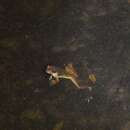fr
noms dans le fil d’Ariane


Trachycephalus macrotis, also known as the Amazonian milk frog and known in Spanish as rana lechera de Pastaza, is a frog in the family Hylidae. It is endemic to Peru and Ecuador. Scientists have seen it between 225 and 925 m above sea level.[1][2]
The adult male frog measures 69.8 to 91.5 mm in snout-vent length and the adult female frog 93.9 to 118.7 mm. Its head is wider than it is long. It has bronze-colored skin with coffee-colored marks. It has some webbing on its feet and relatively small climbing disks on its toes.[2]
This frog engages in explosive breeding after heavy rain.[2]
Trachycephalus macrotis, also known as the Amazonian milk frog and known in Spanish as rana lechera de Pastaza, is a frog in the family Hylidae. It is endemic to Peru and Ecuador. Scientists have seen it between 225 and 925 m above sea level.
The adult male frog measures 69.8 to 91.5 mm in snout-vent length and the adult female frog 93.9 to 118.7 mm. Its head is wider than it is long. It has bronze-colored skin with coffee-colored marks. It has some webbing on its feet and relatively small climbing disks on its toes.
This frog engages in explosive breeding after heavy rain.
Trachycephalus macrotis es una especie de anfibio anuro de la familia Hylidae.[1][2]
Esta especie se encuentra en Ecuador y Perú. Ha sido vista entre 225 y 925 metros sobre el nivel del mar.[2]
La rana adulta macho mide 7.0 a 9.2 cm de largo y la hembra 9.4 to 11.9 cm. Tiene piel de color bronce con manchas café. Tiene discos en sus dedos del pie para subir.[2]
Esta rana reproduce explosivamente durante la estación lluviosa.[2]
Trachycephalus macrotis es una especie de anfibio anuro de la familia Hylidae.
Esta especie se encuentra en Ecuador y Perú. Ha sido vista entre 225 y 925 metros sobre el nivel del mar.
La rana adulta macho mide 7.0 a 9.2 cm de largo y la hembra 9.4 to 11.9 cm. Tiene piel de color bronce con manchas café. Tiene discos en sus dedos del pie para subir.
Esta rana reproduce explosivamente durante la estación lluviosa.